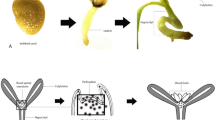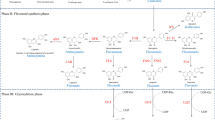Abstract
The putative auxin-transporting cells of the intact herbaceous dicotyledon are the young, differentiating vascular elements. The length of these cells was found to be considerably greater in dwarf (Meteor) than in tall (Alderman) varieties ofPisum sativum L., and to be greater in etiolated than in light-grown plants ofP. sativum cv Meteor andPhaseolus vulgaris L. cv Mexican Black. Under given light conditions during transport these large differences in cell length did not influence the shapes of the transport profiles or the velocity of transport of14C-labelled indol-3yl-acetic acid (IAA) applied to the apical bud. However, in both etiolated and light-grown bean and dwarf pea plants the velocity of transport in darkness was ca. 25% lower than that in light. Under the same conditions of transport velocities in bean were about twice those observed in the dwarf pea. Exposure to light during transport increased the rate of export of14C from the labelled shoot apex in green dwarf pea plants but not in etiolated plants. The light conditions to which the plants were exposed during growth and transport had little effect on the rates of uptake of IAA from the applied solutions. The results indicate that the velocity of auxin transport is independent of the frequency of cell-to-cell interfaces along the transport pathway and it is suggested that in intact plants auxin transport is entirely symplastic.
Similar content being viewed by others
References
Arisz, W.H. (1969) Intercellular polar transport and the role of the plasmodesmata in coleoptiles andVallisneria leaves. Acta Bot. Neerl.18, 14–38
Bonnemain, J.-L. (1971) Transport et distribution des traceurs après application de AIA-2-14C sur les feuilles deVicia faba. C.R. Acad. Sci. (Paris)D273, 1699–1702
Bourbouloux, A., Bonnemain, J.-L. (1974) Transport, distribution et métabolisme de l'auxine dans la racine deVicia faba L. après application de [14C]AIA ou de [3H]AIA sur le bourgeon. Planta119, 169–182
Cande, W.Z., Ray, P.M. (1976) Nature of cell-to-cell transfer of auxin in polar transport. Planta129, 43–52
Cande, W.Z., Goldsmith, M.H.M., Ray, P.M. (1973) Polar auxin transport and auxin-induced elongation in the absence of cytoplasmic streaming. Planta111, 279–296
Christie, A.E., Leopold, A.C. (1965) Entry and exit of indoleacetic acid in corn coleoptiles. Plant Cell Physiol.6, 453–465
Drake, G., Carr, D.J. (1978) Plasmodesmata, tropisms and auxin transport. J. Exp. Bot.29, 1309–1318
Eliezer, J., Morris, D.A. (1979) Effects of temperature and sink activity on the transport of14C-labelled indol-3yl-acetic acid in the intact pea plant. Planta147, 216–224
Gagianas, A.A., Berg, A.R. (1977) The effect of morphactin (methyl 2-chloro-9-hydroxyfluorene-9-carboxylate) on basipetal transport of indol-3-yl acetic acid in hypocotyl sections ofPhaseolus vulgaris L. Ann. Bot.41, 1135–1148
Goldsmith, M.H.M. (1977) The polar transport of auxin. Annu. Rev. Plant Physiol.28, 439–478
Hertel, R., Leopold, A.C. (1963) Versuche zur Analyse des Auxintransports in der Koleoptile vonZea mays L. Planta59, 535–562
Koevenig, J.L., Jacobs, W.P. (1972) Effect of light on basipetal movement of indoleacetic acid in green stem sections ofColeus. Plant Physiol.49, 866–867
Morris, D.A. (1977) Transport of exogenous auxin in two-branched pea seedlings (Pisum sativum L.). Planta136, 91–96
Morris, D.A., Kadir, G.O. (1972) Pathways of auxin transport in the intact pea seedling (Pisum sativum L.). Planta107, 171–182
Morris, D.A., Thomas, A.G. (1978) A microautoradiographic study of auxin transport in the stem of intact pea seedlings (Pisum sativum L.). J. Exp. Bot.29, 147–157
Morris, D.A., Briant, R.E., Thomson, P.G. (1969) Transport and metabolism of14C-labelled indoleacetic acid in intact pea seedlings. Planta89, 178–197
Raven, J.A. (1975) Transport of indoleacetic acid in plant cells in relation to pH and electrical potential gradients, and its significance for polar IAA transport. New Phytol.74, 163–172
Rubery, P., Sheldrake, A.R. (1974) Carrier-mediated auxin transport. Planta118, 101–121
Scott, T.K., Wilkins, M.B. (1969) Auxin transport in roots. IV. Effects of light on IAA movement and geotropic responsiveness inZea roots. Planta87, 249–258
Tammes, P.M.L. (1931) Über den Verlauf der geotrophischen Krümmung bei künstlich tordierten Koleoptilen vonAvena. Rec. Trav. Bot. Neerl.28, 77–81
Thimann, K.V., Sweeney, B.M. (1938) The effect of auxins upon protoplasmic streaming. J. Genet. Physiol.21, 123–135
Author information
Authors and Affiliations
Rights and permissions
About this article
Cite this article
Eliezer, J., Morris, D.A. Cell length, light and14C-labelled indol-3yl-acetic acid transport inPisum satisum L. andPhaseolus vulgaris L. Planta 149, 327–331 (1980). https://doi.org/10.1007/BF00571165
Received:
Accepted:
Issue Date:
DOI: https://doi.org/10.1007/BF00571165




